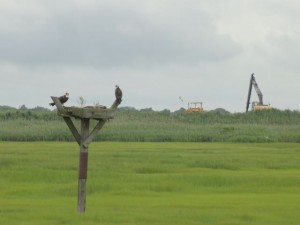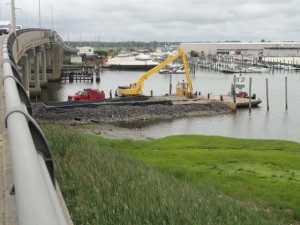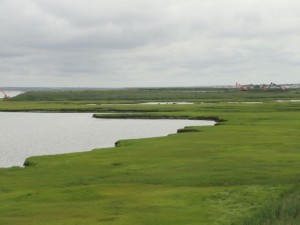A lagoon without water: Snug Harbor (between Eighth and Ninth street in Ocean City, NJ) at low tide on Friday, June 26.
More than 200 people made up a standing-room-only crowd at the Ocean City Community Center's Senior Center on Saturday afternoon as Mayor Jay Gillian outlined plans to dredge shallow waters on Ocean City's bay side.

An osprey platform provides the foreground to Site 83 off Roosevelt Boulevard in Ocean City, NJ and represents the balance regulators face in permitting new dredging disposal sites.
Gillian organized the town hall meeting to address an angry and frustrated community who cannot use their boats for lack of navigable water.
The city has committed funding to make lagoons and channels deeper, but efforts to relaunch a dredging program have been stalled because the city has no place to put the dredged material.
Much of the meeting was informational — outlining the city's past efforts, the current obstacles and an array of future possibilities (
see slides of the entire presentation) — but Gillian gave the crowd some hope that an achievable short-term plan is in place.
- The mayor said he's instructed his administration by next week to apply for permits to build a road to allow trucks to haul away material from a filled-to-capacity disposal site on the marshes near Roosevelt Boulevard (34th Street). He said he has assurances from Department of Environmental Protection Commissioner Bob Martin that the state will work with Ocean City in the permitting process. Hauling material away would make room for more dredging.
- At the same time, the city has permission to use a much smaller disposal site (also accessible by truck) along the Route 52 causeway under the Ninth Street Bridge. The city immediately will seek bids from companies that can remove dredge material mechanically (by digging, instead of pumping with water), a process that would allow trucks to haul away material much more quickly. The process would be used for the sites closest to Ninth Street, including Snug Harbor.
- The city will conduct an engineering survey to assess current conditions and establish a plan and schedule for dredging Ocean City's bay side from "tip to tip."
- "We're going to have to fund this," Gillian said.
- The city will continue to hope for the best in the regulatory process for a number of other more efficient and sustainable dredging programs.
The "amazing undertaking" is to find a way to dispose of an estimated 500,000 cubic yards of material that is clogging up lagoons, channels and private boat slips in Ocean City, Mayor's Assistant Mike Dattilo said.
To understand the cost and magnitude of the task at hand, consider the most immediate plan to dredge just 50,000 cubic yards.

A landing area under the 34th Street Bridge will receive dredge materials from a barge and move them onto trucks bound for Wildwood.
The city will spend $3.6 million just to free up the 50,000 cubic yards worth of space at the 34th Street disposal site, a process that includes moving the material onto barges for a short trip to a staging area under the 34th Street Bridge, where trucks will haul it to Wildwood to help cap a landfill. Ocean City will pay $10 a cubic yard for the privilege of giving Wildwood the material.
The lowest bid on actual dredging (a combined project for Snug Harbor and Carnival Bayou) came in at another $2.6 million.
"The cost of emptying Site 83 is ridiculous," Gillian said. "It's a waste of all your money."
He said being permitted to build the roadway to the site would make emptying it much more cost-effective.

Confined Disposal Facility (CDF) 83 in this view from the 34th Street Bridge.
The city estimates that a temporary road could be constructed for $700,000. Hauling away 250,000 cubic yards might cost $10 million based on recent bids, according to the city's presentation.
One promising idea is to spray a thin layer of material across a wide area to rebuild wetlands (with some sort of mechanism to hold the material in place while it takes root). Ocean City received a grant of more than $2 million from the U.S. Department of the Interior to test the idea, but in the surreal way of bureaucracy, Department of Interior regulations prevent Ocean City from following through, Dattilo said.
The city has budgeted $10 million over the next five years for dredging, the most money ever dedicated to the bayside and a full 12.6 percent of the five-year capital plan, according to Dattilo.
In a session for questions after the presentation, many spoke, most requesting details and assurances about when and where specifically dredging will take place.
Gillian said he was unable to make promises on specific locations, but he said the city was committed to treating all bayside areas equally and to funding a "tip to tip" project.
Because partial dredging of areas could render all work ineffective, private slip owners likely would be able to pay to be included in future projects.
The city is also seek relief on a permitting window that allows work only between July 1 and December 31. Freeholder Marie Hayes, a former marina owner with her husband, Lloyd, said federal agencies have acknowledged that Cape May County has no winter flounder (the basis of the seasonal prohibition on dredging). She said it's now up to the state to see if Ocean City's permitting window could be opened up to the entire year.
 An osprey platform provides the foreground to Site 83 off Roosevelt Boulevard in Ocean City, NJ and represents the balance regulators face in permitting new dredging disposal sites.
Gillian organized the town hall meeting to address an angry and frustrated community who cannot use their boats for lack of navigable water.
The city has committed funding to make lagoons and channels deeper, but efforts to relaunch a dredging program have been stalled because the city has no place to put the dredged material.
Much of the meeting was informational — outlining the city's past efforts, the current obstacles and an array of future possibilities (see slides of the entire presentation) — but Gillian gave the crowd some hope that an achievable short-term plan is in place.
An osprey platform provides the foreground to Site 83 off Roosevelt Boulevard in Ocean City, NJ and represents the balance regulators face in permitting new dredging disposal sites.
Gillian organized the town hall meeting to address an angry and frustrated community who cannot use their boats for lack of navigable water.
The city has committed funding to make lagoons and channels deeper, but efforts to relaunch a dredging program have been stalled because the city has no place to put the dredged material.
Much of the meeting was informational — outlining the city's past efforts, the current obstacles and an array of future possibilities (see slides of the entire presentation) — but Gillian gave the crowd some hope that an achievable short-term plan is in place.
 A landing area under the 34th Street Bridge will receive dredge materials from a barge and move them onto trucks bound for Wildwood.
The city will spend $3.6 million just to free up the 50,000 cubic yards worth of space at the 34th Street disposal site, a process that includes moving the material onto barges for a short trip to a staging area under the 34th Street Bridge, where trucks will haul it to Wildwood to help cap a landfill. Ocean City will pay $10 a cubic yard for the privilege of giving Wildwood the material.
The lowest bid on actual dredging (a combined project for Snug Harbor and Carnival Bayou) came in at another $2.6 million.
"The cost of emptying Site 83 is ridiculous," Gillian said. "It's a waste of all your money."
He said being permitted to build the roadway to the site would make emptying it much more cost-effective.
A landing area under the 34th Street Bridge will receive dredge materials from a barge and move them onto trucks bound for Wildwood.
The city will spend $3.6 million just to free up the 50,000 cubic yards worth of space at the 34th Street disposal site, a process that includes moving the material onto barges for a short trip to a staging area under the 34th Street Bridge, where trucks will haul it to Wildwood to help cap a landfill. Ocean City will pay $10 a cubic yard for the privilege of giving Wildwood the material.
The lowest bid on actual dredging (a combined project for Snug Harbor and Carnival Bayou) came in at another $2.6 million.
"The cost of emptying Site 83 is ridiculous," Gillian said. "It's a waste of all your money."
He said being permitted to build the roadway to the site would make emptying it much more cost-effective.
 Confined Disposal Facility (CDF) 83 in this view from the 34th Street Bridge.
The city estimates that a temporary road could be constructed for $700,000. Hauling away 250,000 cubic yards might cost $10 million based on recent bids, according to the city's presentation.
One promising idea is to spray a thin layer of material across a wide area to rebuild wetlands (with some sort of mechanism to hold the material in place while it takes root). Ocean City received a grant of more than $2 million from the U.S. Department of the Interior to test the idea, but in the surreal way of bureaucracy, Department of Interior regulations prevent Ocean City from following through, Dattilo said.
The city has budgeted $10 million over the next five years for dredging, the most money ever dedicated to the bayside and a full 12.6 percent of the five-year capital plan, according to Dattilo.
In a session for questions after the presentation, many spoke, most requesting details and assurances about when and where specifically dredging will take place.
Gillian said he was unable to make promises on specific locations, but he said the city was committed to treating all bayside areas equally and to funding a "tip to tip" project.
Because partial dredging of areas could render all work ineffective, private slip owners likely would be able to pay to be included in future projects.
The city is also seek relief on a permitting window that allows work only between July 1 and December 31. Freeholder Marie Hayes, a former marina owner with her husband, Lloyd, said federal agencies have acknowledged that Cape May County has no winter flounder (the basis of the seasonal prohibition on dredging). She said it's now up to the state to see if Ocean City's permitting window could be opened up to the entire year.
Confined Disposal Facility (CDF) 83 in this view from the 34th Street Bridge.
The city estimates that a temporary road could be constructed for $700,000. Hauling away 250,000 cubic yards might cost $10 million based on recent bids, according to the city's presentation.
One promising idea is to spray a thin layer of material across a wide area to rebuild wetlands (with some sort of mechanism to hold the material in place while it takes root). Ocean City received a grant of more than $2 million from the U.S. Department of the Interior to test the idea, but in the surreal way of bureaucracy, Department of Interior regulations prevent Ocean City from following through, Dattilo said.
The city has budgeted $10 million over the next five years for dredging, the most money ever dedicated to the bayside and a full 12.6 percent of the five-year capital plan, according to Dattilo.
In a session for questions after the presentation, many spoke, most requesting details and assurances about when and where specifically dredging will take place.
Gillian said he was unable to make promises on specific locations, but he said the city was committed to treating all bayside areas equally and to funding a "tip to tip" project.
Because partial dredging of areas could render all work ineffective, private slip owners likely would be able to pay to be included in future projects.
The city is also seek relief on a permitting window that allows work only between July 1 and December 31. Freeholder Marie Hayes, a former marina owner with her husband, Lloyd, said federal agencies have acknowledged that Cape May County has no winter flounder (the basis of the seasonal prohibition on dredging). She said it's now up to the state to see if Ocean City's permitting window could be opened up to the entire year.